As I warned previously, I am not going to be the one to break any news about Titan’s Simon & Kirby book projects. But the Jack Kirby Weblog has a post about some new information. Not much but it is better then nothing.
Category Archives: Odds & Ends
Marvel Reprints or Marvel Recreations?
Dan Best has an interesting post on his blog 20th Century Danny Boy. It is Original Art Stories: Marvel Masterworks Non-Original Artists. In it he discusses Marvel’s policy of re-creating art when the original stats are not available. It sounds like it is a lot more prevalent then I originally believed. I once wrote a post about Marvel’s reprint of the Human Torch #2 (1). In it I used the term re-inked, but in all honesty re-created is a more accurate description.
Admittedly the original comics were printed with a very primitive type of press. I understand why Marvel would want to use stats when available rather then the original comics. But when original stats are not available the idea that a re-creation is superior to restoring from the original comics is just bizarre. Any re-creation no matter how skillfully done is always one artist’s interpretation of another’s work. This is true even if the original artist is used since so many years have passed. This can be misleading to any comic art historian trying to understand the style of the original penciler or inker. What is worse is Marvel does not even provide any indication as to what stories are based on stats and what are re-creations.
Sky Masters Color Guide, Kirby Kolors?
Ferran Delgado, who as I previously mentioned is working on a Spanish reprint of Sky Masters of the Space Force, has posted an image of a Sky Masters color guide on his blog. There is every reason to believe Jack Kirby did the coloring for the Sky Masters Sunday strips. Therefore the Sunday strips may be the only source to be able to come to a true understanding of Kirby Kolors. It is particularly nice to see an example of the actual color guide. I cannot wait for the final volume (containing the Sundays) of the Spanish Sky Masters reprints to come out.
Please Excuse Me While I Ramble On
I am in a funny situation. Since I am involved in the Titan book deal you would think this blog would be a great source for all sorts of information about the project. Actually that is far from the case. For instance I was scooped on the Titan press release. Not only that but one investigator reported on the deal months ago (and no I will not say who he was and how he did it). It is not that I do not know what is going on. Often I do (however not always) but it is not my position to pass that information along. All news about this project has come from Titan in the past that will continue to be the case in the future. I will pass information along only when it becomes official. I suspect that this blog will not be the first to report project news.
Some people have offered various types of help. It is certainly gratifying to see how willing people are to further not just this project but any that is related to Jack Kirby and Joe Simon. Unfortunately I cannot respond to those offers, at least now.
Although I cannot talk much about the project I do not think it would be wrong for me to comment about the people. I am greatly pleased about the commitment I have seen. Titan wants these volumes to be as good as possible. I do not think fans will be pleased with the books when they are released, I think they will be thrilled. I believe that is what everyone on this projects wants.
Let me wrap this up by expanding my subject matter beyond the Titan book project and talk a bit about recognition. In the past Jack Kirby did not get the credit that he should have. Sure Kirby fans knew how important Jack was, but the public at large did not have a clue. You would have thought that the blockbuster movies based on characters Kirby co-created would have changed the public’s perception (or more accurately lack thereof). But it did not happen. I think that now it is changing and I credit Mark Evanier’s book “Jack Kirby: King of Comics” with being pivotal for that change. However Jack Kirby was not the only one who did not get the recognition that he deserved, Joe Simon did not get the proper credit either. This was particularly depressing to me because some of this neglect originated from people who should have known better. The general attitude was that in the Simon and Kirby collaboration all the art tasks were handled by Jack and Joe only did the business end and some inking. I feel that this is changing as well. More and more I am hearing comments about Joe’s importance. I wish I could say that this blog was instrumental to this change but I know that simply is not the case. My readership is much too small for my efforts to have been the cause. If I am right about the shift in recognition for both Jack Kirby and Joe Simon, the future should be very exciting times for their fans.
Timely and the Romance Glut
In Chapter 6 of “The Art of Romance” I presented a graph of romance titles that vividly depicted what Michelle Nolan described in her book “Love on the Racks” as the love glut. I mentioned that the two greatest participators in this rush to produce romance comics were Timely and Fox Comics. The reward received by Fox Comics for their zealous jump into love comics seems to have been the bankruptcy that terminated the company a few months afterwards. Timely obviously survived, but I wondered if more could be determined about what effect the love glut had on them? This time I turned to Atlas Tales (what a great site). I used their search engine to provide all the titles between August 1948 and June 1951. I then entered that information into a database and segregated the titles to romance and non-romance.
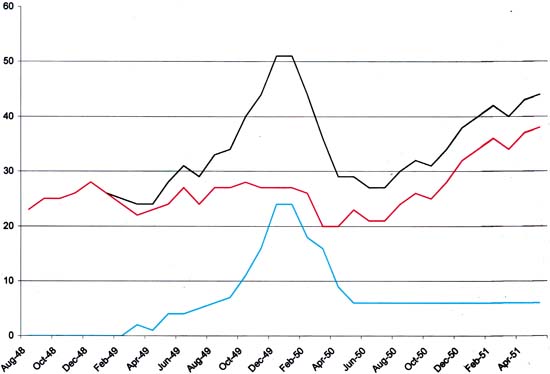
Chart of Timely Titles (Romance titles in blue, non-Romance titles in red, and the combined titles in black).
The resulting graph is not perfectly smooth but it still is revealing. It looks to me that when romance titles were first introduced they took the place of other genre comics as shown by the small dip. However the non-romance genres quickly recovered to their pre-romance levels while more and more romance titles were added. Finally a maximum of 24 romance titles were reached, just 3 titles short of all the other genres combined. This was followed by the crash. Now the cancellation of romance titles is expected but note that the non-romance titles also dipped in February 1950. This suggests that the glut resulted in enough of a financial loss that it impacted other titles as well. As I mentioned in Chapter 6 a low of romance titles was achieved in November of 1950 after which the number of romance titles began to climb although never reaching anything near the levels at the peak of the glut. Timely did not participate in this resurgence and instead maintained a steady level of 6 romance titles for the period covered. The non-romance Timely titles quickly returned to their pre-glut levels (by September 1950) and then continued to levels even higher then before the glut. Whatever financial loss Timely suffered was short lived. I wondered if the even higher levels that Timely achieved after the love glut could have been at the expense of other publishers, like Fox, who were not able to recover so quickly?
New Volume of Sky Masters of the Space Force
I have recently obtained a copy of “Sky Masters of the Space Force” Libro 1. This is the first of what should become a three volume set. The restoration of the newspaper strips were made by Ferran Delgado, who has his own blog. I am of the habit of periodically visiting his blog just to look at the beautiful images of comic art that he provides. Unfortunately I have a serious problem with his blog and this “Sky Masters” book as well, no hablo Espanol. I took three years of Spanish in high school but I am afraid I passed only because I was the quietest person in the class.
Still I am particularly looking forward to the volume containing the Sky Master Sunday strips. Ferran has posted some of his restorations and one of them has also appeared in Mark Evanier’s “Jack Kirby: King of Comics”. These restorations are nothing short of drop dead gorgeous. Ferran is taking great care to faithfully restore the original colors of the printed version. Readers of my blog should not be surprised to find that I feel recoloring was one of the greatest banes of earlier reprints of material drawn by Jack Kirby. This particularly egregious in the case of Sky Master because there is every reason to believe that Kirby did the original color guides himself. It is much more likely that work done for the Sky Master in the late fifties could lead an understanding of the true nature of Kirby Kolors then any of the work that Jack did in the ’80s or ’90s.
So congratulations to Ferran Delgado for successfully bringing the first volume of Sky Masters to print. I know it required a lot of work, but the result certainly justifies the effort.
It’s Official, Titan to Publish Simon & Kirby
It’s Official, Titan to Publish Simon & Kirby
Yes it is official:
Titan Publishing Group Ltd. has announced the acquisition of worldwide rights to a range of books celebrating the work of Golden Age comics legend, Joe Simon, co-creator of Captain America. Throughout his career, Simon pioneered every aspect of the industry, from writing to art, editing to publishing. He ran a studio that employed some of the industry’s most talented artists, including the famed Jack Kirby. He was the first editor in chief of the company that became Marvel Comics, and ultimately played a pivotal role in comics’ transcendence to an American art form.
Scheduled for spring 2009 is Joe Simon: The Man Behind The Comics, an in-depth illustrated autobiography written by Simon himself, taking readers on an illustrated journey through the life and career of this seminal figure in comics history. From his beginnings in newspaper cartooning through the birth of the comics medium, military service during World War II, the Kefauver hearings and beyond, this volume reveals the man and his work.
Further volumes will celebrate the collaborative efforts of Joe Simon with Jack Kirby. The Best Of Simon & Kirby, a deluxe hardcover edition, explores the duo’s acclaimed proliferation of work in all genres, including superheroes, horror, detective fiction, westerns, and the first of the romance comics. The Simon & Kirby Superheroes delves into the duo’s work that set the standard for costumed characters through heroes such as Blue Bolt, Fighting American, Stuntman, and the Fly.
Compiled with unprecedented access to rare archive material and exclusive contributions from Joe Simon, these are the only editions authorized by both Joe Simon and the estate of Jack Kirby, marking the beginning of a line of publishing that will offer an unprecedented look at the Dream Team of Golden Age comics.
Let me emphasize that last paragraph, both Joe Simon and the Jack Kirby estate will financially benefit from these books.
On a more personal note this is the culmination of the dream I have had for some years. And yes I will be involved in this project. It will undoubtedly mean a lot of work for me. Hopefully I can do it while also continuing my regular posting to this blog.
Joe Simon and Timely Detective Magazines
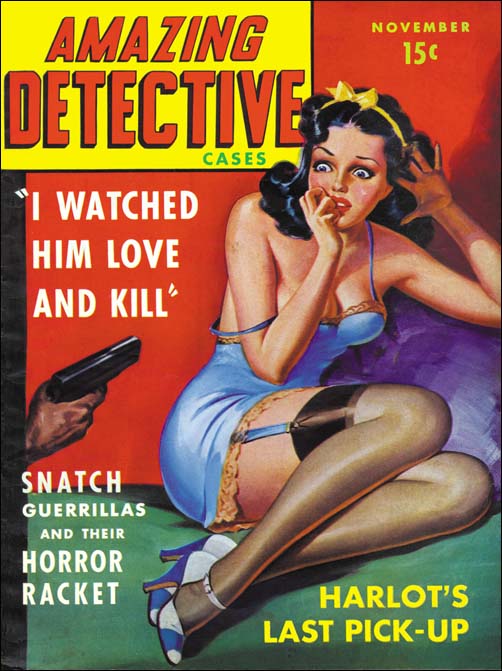
Amazing Detective Cases vol. 1 no. 7 (November 1941) unidentified artist
Joe Simon was working as a freelance editor for Fox Comics for only a three month period before he left to take a position with Timely, still on a freelance basis. Some scholars have described Joe’s job at Timely as a General Editor but in his recent interview (Jim Amash, Alter Ego #76) Joe described it as Art Editor. Those that prefer to call Joe a General Editor usually give the Art Editor title to Jack Kirby. As far as I can tell the allocation of titles has been solely based on the testimony of either Joe Simon or Jack Kirby. Personally I suspect that at the time job titles held no real significance for Martin Goodman the only thing that mattered was the work to be done.
The work that generally holds the interest for most was for the comic books. Unfortunately none of the comics provide credits for the editorial personnel. Kirby did most of the drawing during the Timely period but Joe did some as well either alone or with Jack. But who did the drawing is not the issue here. One interesting suggestion comes from the splash to a Captain Daring story from Daring Mystery #7 (April 1941). The drawing for the story was all by Jack except for the figure of Captain Daring in the splash. That substitution is not what would be expected if Jack was the Art Editor. Otherwise I have not seen any evidence to help in this question about editorial attributions. This record stands in sharp contrast to Simon and Kirby’s post-war collaboration where a good number of examples of Kirby altering another artist’s work have been found along with some by Simon as well.
Comic books were not the only publications produced by Timely at this time. Pulps still played an important part of the company’s income. However so far I have found no help from the pulps about editorial functions either. Kirby does provide much of the art used to illustrate pulp stories but Simon and other artists show up as well. No editorial credits are provided. Joe has said (Alter Ego #76 interview) that he was not an editor for the pulps, he only put them together.
Although the artistic contributions to Timely’s comic books and pulps has been well known for some time, another of the publisher’s products, magazines, has generally been overlooked. Fortunately Kirby scholar and sleuth Tom Morehouse has been actively investigating Timely magazines. A number of magazine illustrations by Jack Kirby that Morehouse uncovered were included in the back of Greg Theakston’s “The Comic Strip Jack Kirby” Recently Tom has kindly loaned me some copies of Timely magazines with examples by other artists. Simon has described these magazines as “flats” which are “glossy magazines without the gloss”.
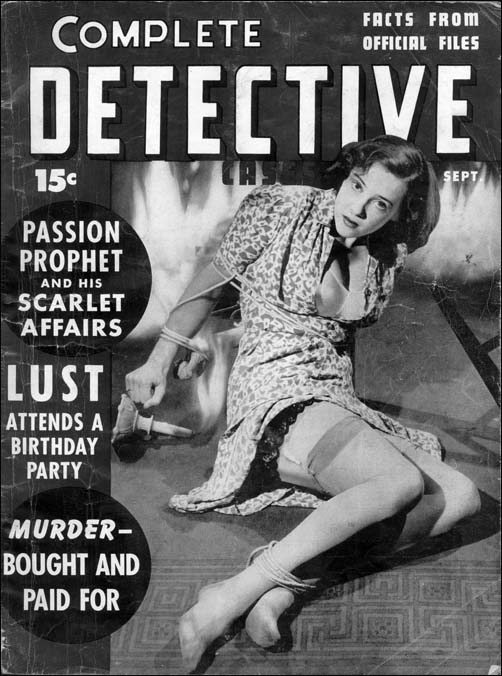
Complete Detective Cases vol. 3 no. 5 (September 1941)
The Timely periodicals under consideration are all detective magazines; Amazing Detective Cases, Complete Detective Cases and National Detective Cases. Amazing Detectives Case is listed as being published by Crime Files Inc. while Complete Detective Cases and National Detective Cases are said to be by Postal Publications Inc. However this is nothing more then the use of multiple company names by publishers of that day. It is not clear why Timely and other publishers did this but since it was such a common practice there must have been some benefit. These detective magazines are filled with supposedly true stories about various criminals. Stories of murder and other lurid crimes predominate throughout. A look at the covers reveals another important aspect of the magazines appeal. The five covers I borrowed all show images (four using photographs and one a painting) of a woman, generally bound. The recurring characteristic of these covers seems to be the showing of as much legs and cleavage as possible. Frequently words like sex and lust are prominently displayed on the cover. At the time these magazines would not have been considered respectable, but where they thought to be pornographic? I do not know about 1941, but in January 1958 issues of Complete Detective Cases and Amazing Detective Cases were list as prohibited on the grounds of that they were indecent or obscene as covered by the Censorship of Publications Act.
As with the pulps, most of the art used in the detective magazines was by Jack Kirby with other artists providing less numerous contributions. What is of particular interest is that the contents pages of all the magazines examined so far consistently list Joe Simon as the Art Director. (In his Alter Ego #76 interview Joe says the editor was named Levi but the content pages list him as Robert E. Levee. But who knows perhaps, as was so common in those days, the editor was trying to use a name that was less obviously Jewish.) The dates of the magazines known to include Simon credits as Art Director range from November 1940 through July 1941. As not all of the Timely detective magazines have been examined and Joe’s employment at Timely covered a greater period, further Timely detective magazines listing Simon as Art Director will undoubtedly be found.
The Timely detective magazines included extensive use of black and white photographs throughout the interior. This meant that better printing presses were used then those for the interiors of either comic books or pulps. Art generated for the magazines did not have to be the inked pencils used for comics nor the stipple boards frequently used for pulp illustrations. Instead the art was generally ink washes but some may have been done with an air brush. Pretty much any technique that an artist might desire to use could be accommodated except the use of color. Some of the photographs appear to have been retouched with an air brush. Sometimes this was done to improve an inferior photograph. The photographs looked like they were obtained from a variety of sources both professional (police files) and amateur. In other cases an air brush was used to add features that were not originally in the photo. For example firing blasts from gun barrels or flames of a fire (see the Complete Detective vol. 3 no. 5 cover shown above). I do not know whether Simon did the various photograph alterations himself but he certainly was capable of it. Joe’s previous years as a newspaper staff artist included a lot of photograph retouching with an air brush.
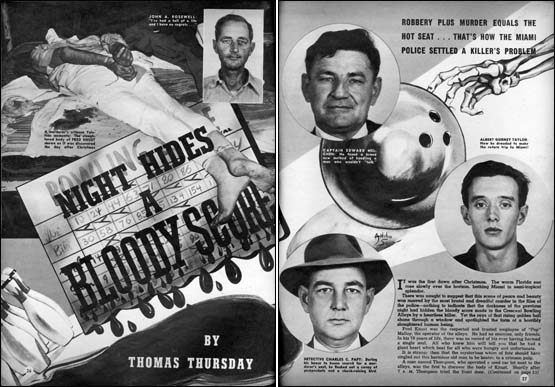
Complete Detective Cases vol. 3 no. 5 (September 1941) “Night Hides a Bloody Score” Artilio Sinegra (signed)
As Art Director, Joe Simon was also involved with the layouts used in the magazines. In his previous job as a newspaper staff artist, Simon had very likely been called to do paste-ups. However I doubt that the work he did for the newspapers had the unusual layouts found in these Timely detective magazines. In the magazines photographs were combined in unusual manners and art work would sometimes be mixed in. The first two pages for “Night Hides a Bloody Score” shown above is a good example. The art was signed by Artilio Sinegra, an artist I have not found any information on. I doubt that Sinegra had anything to do with the design of the spread. In this example circular photos were included on the right page so as to correspond to the form of the bowling ball. The legs of the dead man on the left page first underlie then intrude over the title. The body on the left forms a diagonal that is counter balanced by that formed by the skeletal arm, bowling ball, title and pins. This emphasis on design is characteristic of some of the comic book work particularly the double page splashes from Captain America. (See the chapters about Captain America #6, #7, #8, #9, and #10 of my serial post the Wide Angle Scream) Such designs are present throughout the detective magazines I have seen, even when other artists were used or in layouts consisting solely of photographs. I conclude that whether or not he did the actual paste-ups, Joe Simon was responsible for the designs. Only one of the magazines that Tom loaned to me was from early during Joe’s time as Art Director but it does suggest that perhaps Joe started out with simpler designs and progressively got more inventive. These Timely magazines may provide the means of showing Joe acquiring his skills at layout that he would use throughout the rest of his career.
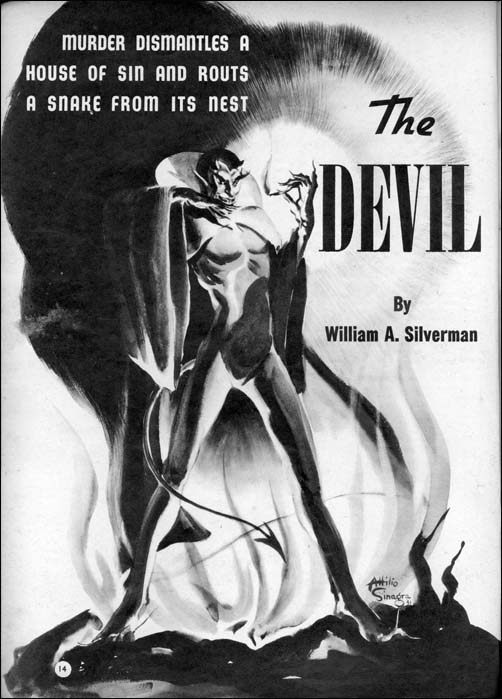
Complete Detective Cases vol. 3 no. 5 (September 1941) “The Devil Strikes a Match” Artilio Sinegra (signed)
Photographs were the primary sources used for the introduction to a story and illustrations generally played a more minor roll. However in some cases the introduction was only artwork. “The Devil Strikes a Match” has an ink wash by Artilio Sinegra. Since I have never come across his name as a comic book artist, perhaps he only did illustrations. The two signed works by Sinegra that I have provided above are the only ones that I can safely attribute to him.

Complete Detective Cases vol. 3 no. 2 (March 1941) “The Mask Man of the Middle West”, art by Al Avison
Tom Morehouse has provided me with information for 15 Timely detective magazines. In this group there are a total of 30 illustrations that are either signed or can be attributed with reasonable certainty. There are a number of incidental graphic additions that just are not sufficient to even provide a guess as to the creator. The majority (19) of the illustrations were done by Jack Kirby. The next most prolific artist was Al Avison who I credit with 5 certain and 2 possible illustrations. The example I provide above is perhaps the best one. I like Avison’s work but his early stuff tended to be a little crude and his talent only really blossomed after Simon and Kirby left Timely. In this case he has created a great composition. The low angle provides an interesting view and I am sure Martin Goodman appreciated the lengthy legs as well. A similar importance placed on attractive legs can be found in another Al Avison illustration (“I Watched Him Love and Kill”, v. 1 no. 7, November 1941).
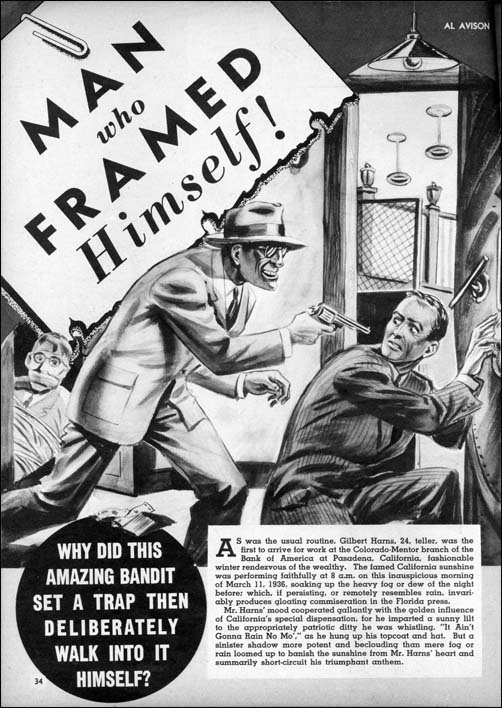
Amazing Detective Cases vol. 1 no. 7 (November 1941) “Man Who Framed Himself”, art by Al Avison (signed)
Unfortunately the rest of his illustration work was not nearly so well done. I thought I should include at least one other Avison illustration to give a more balanced view of his work in the Timely detective magazines. Even though it shares the same theme of an armed safe robbery it is not anywhere nearly as interesting as “The Mask Man of the Middle West”.

Complete Detective Cases vol. 3 no. 6 (November 1941) “Detroit’s Zombi”, art by Al Avison?
The art with the unusual witch-like creature for “Detroit’s Zombi” is unsigned. I cannot say precisely why, but it looks like Avison’s work to me. There is some similarity to the crude bat with one on a cover that Al did for Speed Comics #15 (November 1941) but both are nothing more then primitive silhouettes so I would not want to make too much of that similarity. The witch has a striking resemblance to the one of the Simon and Kirby wide splash for Captain America #8 (November 1941). The Kirby touch is clear in the Cap splash but he certainly did not draw the illustration for “Detroit’s Zombi”. However I am sure Kirby’s witch was the model that, shall we say, inspired Avison’s version. Incidentally the image of the young girl is one of those retouched photographs I mentioned before. In this case the photo has been so heavily work on with an air brush that it now blurs the distinction between photography and painting.

Complete Detective Cases vol. 3 no. 2 (March 1941) “Cop Killer on the Loose”, art by Joe Simon (signed)
Among the 30 illustrations that have so far been inventoried there are two by Joe Simon. Joe had experience at doing ink wash illustrations during his time as a newspaper staff artist. His brush work is truly confident as he combines detailed work (such as in the figures) with more sketchy rendition (particularly the background walls). The way Joe handles round stones in the wall is very reminiscent of some of his comic book work, for instance the cover for Weird Comics #3 (June 1940) or the Fiery Mask story “The Strange Case of the Bloodless Corpses” (Human Torch #2(1) Fall, 1940). Both Joe and Jack showed in these magazine illustrations a willingness to use bold brush strokes that is prescient for the work that they would do after the war.
I would like to extend my thanks to scholar Tom Morehouse for sharing these Timely detective magazines with me and allowing me to use them in this blog.
“Love on the Racks” the Most Important Book of Comics Ever
Okay there is a lot of hyperbole in my title. But think about it, at their height one out of four comic titles on the racks was a romance comic. Romance comics lasted about 30 years not counting a couple of failed retry attempts. Yes some types of comics were more enduring, but most were not. There were long periods when more romance titles out then those for superheroes. I have previously discussed how during his time in partnership with Joe Simon, Jack Kirby drew more pages of romance then all other genre combined. Today one can find numerous books covering different aspects of comic history, yet “Love on the Racks, A History of American Romance Comics” by Michelle Nolan is the first to provide an overview for the romance genre. It was worth the wait.
For me personally, this book came out just in time. In it I found the answers to a couple of puzzles concerning the subject of my next chapter of the serial post “The Art of Romance”. Because their romance titles were so important to Simon and Kirby I have spent much time studying them. However Prize and Mainline were really small publishers and this book provides a welcome overview of the other publishers of romance and their comics. Despite what you might think, romance comics were not all the same.
Nolan does an excellent job of reporting on her subject. Not only are we provided with reviews of some of the romance titles but Nolan also gives data to help show the ups and downs of love comics. The data she uses is very revealing but I must admit that it was sometimes hard to keep track of it all. I believe it would have been better had Nolan provided some graphs. In fact spurned on by what I read, I have done just that. Using Dan Stevenson’s list “All the Romance Comics Ever Published (?)” as a primary source I have graphed romance titles over their history and the results are very useful. It is all covered in “Love on the Racks” but the graphs make it more easily grasped. I will be making use of these graphs in my future posts.
I did find one minor error; Young Romance did not go monthly with issue #9 as Nolan reports rather that happened nine months later with Young Romance #14. It was not so much an error but the author expressed being perplexed about Prize replacing Young Love with their new All For Love in 1956/57 and then in 1959/60 switching All For Love back to Young Love as well as changing Personal Love to Going Steady. As I covered in chapter 9 of my serial post “The End of Simon and Kirby” Prize was undoubtedly having money problems in 1956. Prize’s contract with Simon and Kirby meant they shared the profits with those creators. One way to save money was to cut Joe and Jack out, but the contract probably prevented them from just removing them from Young Love. So Prize did the next best thing and cancelled Young Love and replaced it with a new title, All For Love. They probably got cold feet about doing the same thing to their flagship love title Young Romance. I also discussed how Mike Bleier, one of the owners for Prize, died and Teddy Epstein asked Joe Simon to take the lines over. Joe probably felt, correctly, that Young Love was a better title then All For Love as was Going Steady compared to Personal Love. In the end even Going Steady was not good enough but Young Love would go on to become the last romance comic book even outlasting Young Romance.
I suspect many comic book historians may not consider romance comics as having much importance in relationship to their main areas of interest, usually superheroes. Well think again. Chapter 5, “The Love Glut” should be required reading for any comic fan with an interest in such companies as Fox or Timely/Atlas. As Nolan shows the over zealous entry into love comics by some publishers had disastrously results. I remember some time ago there was much speculation on a Timely/Atlas list as to what happened to that company in 1950. Nolan’s Love Glut is pure smoking gun. The money Victor Fox lost during this period was almost certainly the reason that he went bankrupt a half a year later.
Hyperbole aside, this book is probably not of interest to everyone. But I strongly suggest any comic book historian with an interest focused on some particular publisher should certainly read this book.
Kirby Five-Oh
One of my biggest treats from the 2008 New York Comic Con was being able to pick up a copy of The Jack Kirby Collector #50, titled “Kirby Five-Oh”. TwoMorrows wanted to make something special for their fiftieth issue of their flagship title and they have succeeded. The Jack Kirby Collector has been an oversized magazine for some time but this one is thick as well. And it ain’t just fluff! There are page after page of just fantastic Kirby art including a great color section. The 50 theme rules with chapters such as the 50 greatest Kirby covers, the 50 greatest Kirby stories and the 50 greatest Kirby creations (I do not have the issue in front of me as I write this so I am probably forgetting some). I would highly recommend the purchase of this volume but I suspect most of my readers regularly pick up The Jack Kirby Collector anyway.
In the past I have occasional given help to The Jack Kirby Collector as well as to their other great publication, Roy Thomas’ Alter Ego. For the Kirby Five-Oh I was able to provide more then I have ever been able before. I hope my readers will be indulging as I take pride in my contribution which, although only a small part of that issue, was large compared to my previous efforts. I was able to do this because of a project I once did. Back in 1998 I decided to restore the line art for all the published covers that Kirby or Simon drew during their partnership. It was a pretty bold decision since that meant a lot of covers and only a small fraction of which were available to me at the time I started. I wanted to restore the line art because color printers then were expensive and not very good while black and white laser printers were available and could do an excellent job. I certainly could not afford to chemically bleach the covers, the standard technique for that type of restoration in those days. I had some experience with Photoshop and decided to see what I could devise to digitally bleach cover scans. I did come up with a process that worked reasonably well but still required a lot of work of clean up (digital bleaching can never do quite as good a job as the chemical version). Between tracking down comics or scans of the covers, and all the work in Photoshop, it was not until about 2003 that I completed my project. My research since then has shown I made a few mistakes but it is still an undertaking that I am very proud of. Because of copyrights issues, publication of my efforts was never a realistic consideration nor could I legally sell copies of the volumes I did hand make. Some of my restorations appeared in the latest reprint of Joe Simon and Jim Simon’s “The Comic Book Makers”. However all but one (Captain America #7) were much reduced images. John Morrow, who knew about my project, asked if I could supply some images for his chapter on the 50 best Kirby covers. The result was that all the covers in that particular chapter of Kirby Five-Oh from Captain America #1 up to Foxhole, and Race to the Moon as well, are all my restorations from my project. My restoration for Star Spangled #9 shows up later in the magazine and they did a clever alteration of my Adventure #84 for the volume’s introduction. The images for the 50 best Kirby covers are presented four to a page but since the Jack Kirby Collector is an oversized publication that is a pretty good size. It is really great to see some of my restorations actually in print.
(added later)
In the comments Ger suggested that I provide a link the Yahoo group where I discussed more fully my techniques for restoring comic scans. I do not discuss such things here as there really is not much interest in such esoteric knowledge. The group is Digitizing Comics but it is a very dormant group. Membership is required but since I am the moderator that will be no problem. Those interested in trying my methods would need a scanner and Photoshop. My posts can be found in the Archives and I would happily answer any questions there.

